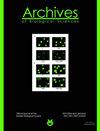MIR-548ar-3p increases cigarette smoke extractinduced chronic obstructive pulmonary disease (COPD) injury through solute carrier family 17 member 9 (SLC17A9)
IF 0.8
4区 生物学
Q4 BIOLOGY
引用次数: 0
Abstract
This study investigated the effect of microRNA mir-548ar-3p on cigarette smoke extract (CSE)-induced chronic obstructive pulmonary disease (COPD). High-throughput sequencing was performed on peripheral blood from smoking COPD patients and non-smoking individuals with normal pulmonary function, and mir-548ar-3p RNA, possessing large differential expression was selected. Experimental groups were divided into control, experimental model (EM), EM+mimic miRNA, negative control (NC) and EM+miR-548ar-3p groups; an empty vector or miR-548ar-3p mimic was transfected into human bronchial epithelial (HBE) cells. A COPD model was established by treating HBE cells with CSE. Cell viability, apoptosis and solute carrier family 17 member 9 (SLC17A9) protein expression were examined by cell counting kit-8, flow cytometry and Western blotting, respectively. Cell viability in the EM+miR-548ar-3p group decreased significantly, and the apoptosis rate and SLC17A9 protein expression increased significantly compared with the control (P<0.05, all groups). In smoking COPD patients, interferon (IFN)-? and interleukin (IL)-17? expression detected by ELISA was significantly higher than in normal individuals. miR-548ar-3p expression was significantly lower (P<0.05, all groups). These findings suggest that miR-548ar-3p was expressed at a lower level in COPD patients. miR-548ar-3p may increase the extent of CSE-induced COPD injury through SLC17A9.MIR-548ar-3p通过溶质载体家族17成员9 (SLC17A9)增加香烟烟雾提取性慢性阻塞性肺疾病(COPD)损伤
本研究探讨了microRNA mir-548ar-3p在香烟烟雾提取物(CSE)诱导的慢性阻塞性肺疾病(COPD)中的作用。对吸烟COPD患者和肺功能正常的非吸烟患者外周血进行高通量测序,选择差异表达量较大的mir-548ar-3p RNA。实验组分为对照组、实验模型组(EM)、EM+模拟miRNA组、阴性对照组(NC)和EM+miR-548ar-3p组;空载体或miR-548ar-3p模拟物转染到人支气管上皮细胞(HBE)中。用CSE治疗HBE细胞建立慢性阻塞性肺病模型。分别采用细胞计数试剂盒-8、流式细胞术和Western blotting检测细胞活力、细胞凋亡和溶质载体家族17成员9 (SLC17A9)蛋白表达。EM+miR-548ar-3p组细胞活力显著降低,细胞凋亡率和SLC17A9蛋白表达均显著高于对照组(P<0.05)。在吸烟的COPD患者中,干扰素(IFN)-?白细胞介素(IL)-17?ELISA检测的表达量明显高于正常人。各组患者miR-548ar-3p表达水平均显著降低(P<0.05)。这些发现表明,miR-548ar-3p在COPD患者中的表达水平较低。miR-548ar-3p可能通过SLC17A9增加cse诱导的COPD损伤程度。
本文章由计算机程序翻译,如有差异,请以英文原文为准。
求助全文
约1分钟内获得全文
求助全文
来源期刊
CiteScore
1.40
自引率
0.00%
发文量
25
审稿时长
3-8 weeks
期刊介绍:
The Archives of Biological Sciences is a multidisciplinary journal that covers original research in a wide range of subjects in life science, including biology, ecology, human biology and biomedical research.
The Archives of Biological Sciences features articles in genetics, botany and zoology (including higher and lower terrestrial and aquatic plants and animals, prokaryote biology, algology, mycology, entomology, etc.); biological systematics; evolution; biochemistry, molecular and cell biology, including all aspects of normal cell functioning, from embryonic to differentiated tissues and in different pathological states; physiology, including chronobiology, thermal biology, cryobiology; radiobiology; neurobiology; immunology, including human immunology; human biology, including the biological basis of specific human pathologies and disease management.

 求助内容:
求助内容: 应助结果提醒方式:
应助结果提醒方式:


